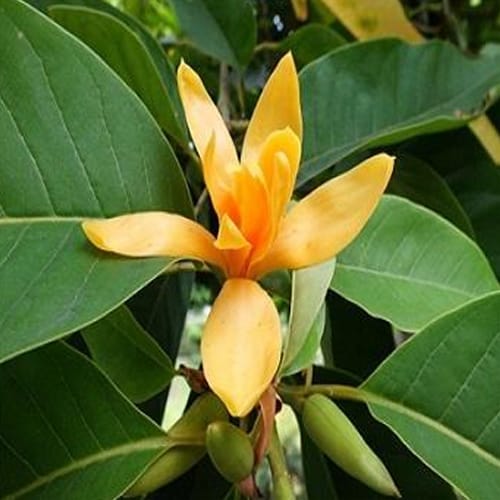Champa - Sonchafa

listen about me
Michelia champaca
Classification:
Kingdom: Plantae
Division: Magnoliophyta
Class: Magnolipsida
Order: Magnoliales
Family: Magnoliaceae
Genus: Michelia
Species: champaca
Scientific Name: Michelia champaka L.
Common Name-
English : Champa, Golden Champa.
Hindi: Champa.
Marathi: Sonchafa.
Description:
1. Habit and Habitat: Champa is very well known flower native to the
Himalayas, and popular for its fragrant flowers. It is a tree up to 50 m or taller, up to 1.9 m Trees, buttressed, up to 30 m tall.
2. Distribution: Champa is found in the Himalayas, up to NE India and SE
Asia, at altitudes of 600-1300 m. native to the Indomalaya ecozone,
consisting of South Asia, Southeast Asia−Indochina, and southern China.
It is found in Tropical and subtropical moist broad leaf forests.
3. Morphology:
Leaf: Leaves simple, alternate, spiral; petiole 1-3 cm long, stout and
planoconvex in cross section; lamina 9.5-25 x 3.5-9 cm, elliptic-
lanceolate, apex acuminate with twisted acumen, base acute to
attenuate, margin slightly undulate, glabrous, chartaceous; midrib
nearly flat above; secondary nerves 12-16 pairs; tertiary nerves closely
and strongly reticulate.
Inflorescence: solitary, axillary.
Flowers: Flowers solitary, axillary, large, yellow, fragrantUsually nine
tepals, 3 whorls of 3 each; either all the 3 whorls petalloid or sometimes
the outermost of 3 tepals becomes sepaloid than calyx and corolla and
described as under.
Androecium: Indefinite, polyandrous, spirally arranged, distinguished
into filament, connective and anther lobes, dithecous, basifixed,
dehiscence longitudinal, extrorse.
Gynoecium: Polycarpellary, apocarpous; superior; spirally arranged on a cone like and elongated thalamus; each carpel with a swollen ovary, curved style and beaked and simple stigma, unilocular; placentation marginal, many ovules in each carpel.
Fruit: An etario of follicles, dark coloured with white specks.
Seeds: Seeds 2-4 per carpel, rugose.
Flowering and Fruiting time: February -June.
4. Propagation: Through seeds, Grafting, Cuttings.
5. Importance:
a.it is used for worship at temples whether at home or out, and more
generally worn in hair by girls and women as a means of beauty
ornament as well as a natural perfume.
b. The tree was traditionally used to make fragrant hair and massage oils.
c. wood, which is used in furniture making, construction, and cabinetry.
d. The bark is used as a febrifuge.
e. A decoction of the bark and leaves is given after child birth.
f. The flowers are used to treat leprosy.
g. The leaves are used as a treatment against colic.
h. Soil under tree cover shows an increase in pH, soil organic carbon and available phosphorus.
